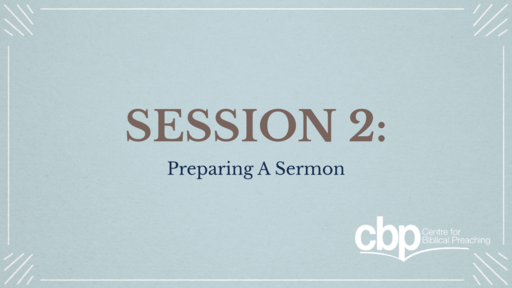2. How to Prepare A Sermon
Notes
Transcript
PREACHING CONFERENCE
Centre for Biblical Preaching / Grace Christian Church Buderim
By Michael Raiter
INTRODUCTION
‘Through the long history of the church, nothing has won as many souls, changed
as many lives, built up as many saints, and strengthened as many churches as the
faithful preaching of God’s Word. Although there are many other ways to
communicate the gospel and edify God’s people, in his wisdom God has given
preeminence to the preaching of his Word. His Word is powerful and, when it is
proclaimed clearly and its message is applied pertinently to those who listen, it
has massive, Spirit-laden potential to change lives, either suddenly and
dramatically or quietly and incrementally.’
-
Murray Capill, The Heart is the Target
SESSION 1 - WHAT IS BIBLICAL PREACHING?
MY CONVICTIONS
1. Preaching is my first work
2. A preaching ministry comes to you
3. Preaching creates a culture
4. For the glory of God
1
5. It’s a work that I can always improve on
6. People love good preaching
7. Preaching is hard work
8. ‘Blessed!’
PREACHING DEFINED
Preaching is the explanation, application and proclamation to the mind, heart and
will of God’s timeless word for the transformation of this people at this particular
place and time.
A WORD FROM NEHEMIAH 8:1-12
2
SESSION 2 - PREPARING A SERMON
Matthew 7:24-27
'“Everyone then who hears these words of mine and does them will be like a wise man
who built his house on the rock. And the rain fell, and the floods came, and the winds
blew and beat on that house, but it did not fall, because it had been founded on the rock.
And everyone who hears these words of mine and does not do them will be like a foolish
man who built his house on the sand. And the rain fell, and the floods came, and the
winds blew and beat against that house, and it fell, and great was the fall of it.”'
-
Matthew 7:24–27 (ESV)
1. READING
Start early!
Step 1: Read through the passage.
Step 2: What’s the Main Idea?
Step 3: What’s the Structure?
Step 4: Identify any difficult issues that will need to be addressed.
Step 5: Read the wider context
3
Step 6: Read 2-3 commentaries on the passage.
●
understanding of the text – resolution of any difficult issues
●
be clear on the main point or points
●
perhaps some illustrations and application
Step 7: What’s the Main Idea (again)?
2. WRITING
●
The best hours
●
Mental blocks
●
Constant checking
o
is it faithful to the text?
o
is it clearly structured?
o
is it engaging?
o
do the illustrations work?
o
are the applications appropriate?
4
3. REHEARSING
HOW LONG?
1. Reading:
2- 3 hours
2. Writing:
4 hours
3. Rehearsal:
1 - 2 hours
FULL TEXT?
Strengths and Weaknesses of Full Text
●
Every word counts
●
It allows me to check the accuracy of the sermon.
●
I can check its interest level.
●
If I have a mental blank then I have the safety net of a full text.
●
I can use it again.
●
It makes it easier to practice the sermon
●
I have a manuscript.
●
I can estimate the length of the sermon
●
The great danger – the read sermon
The Case for Notes or No Notes
●
It cuts down on preparation time.
●
It allows for more spontaneity and naturalness
●
Notes work for those who think well on their feet
5
